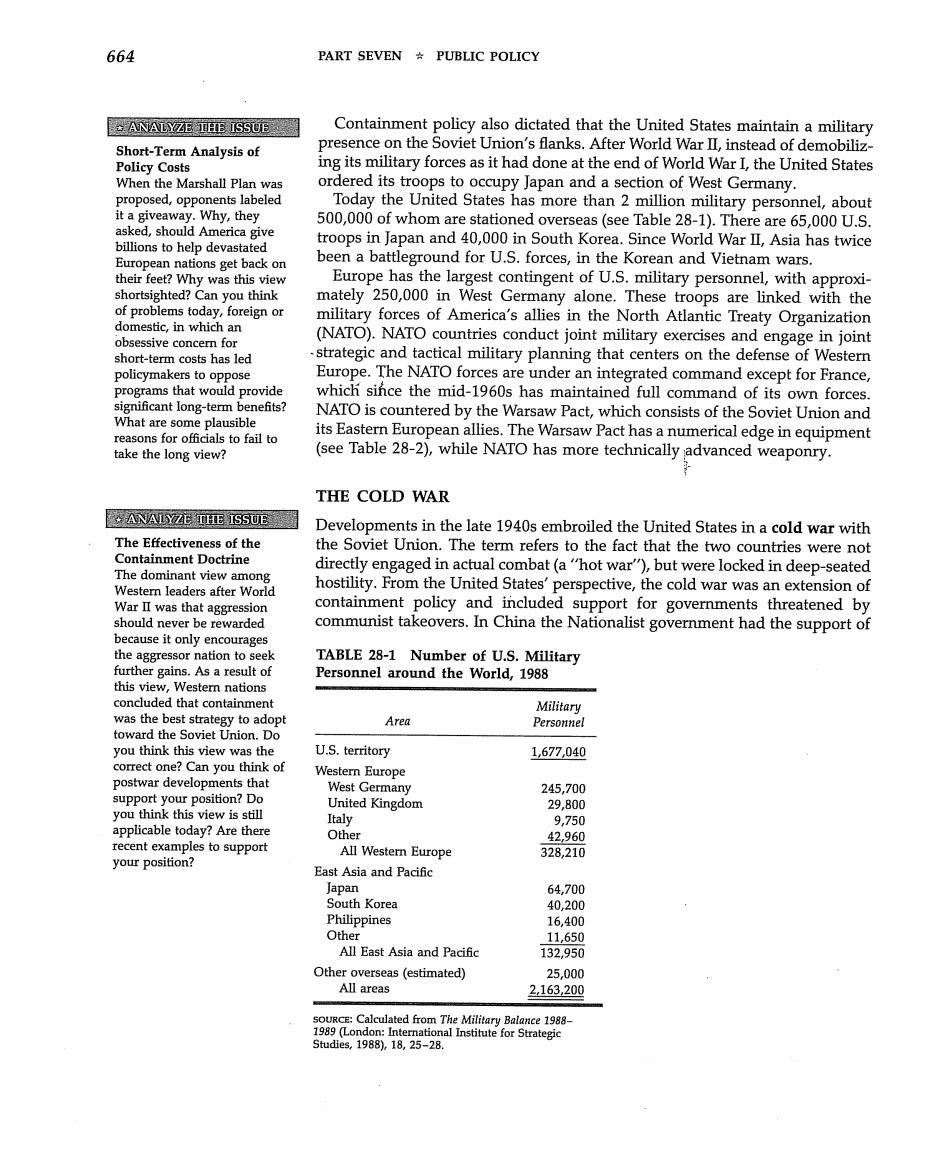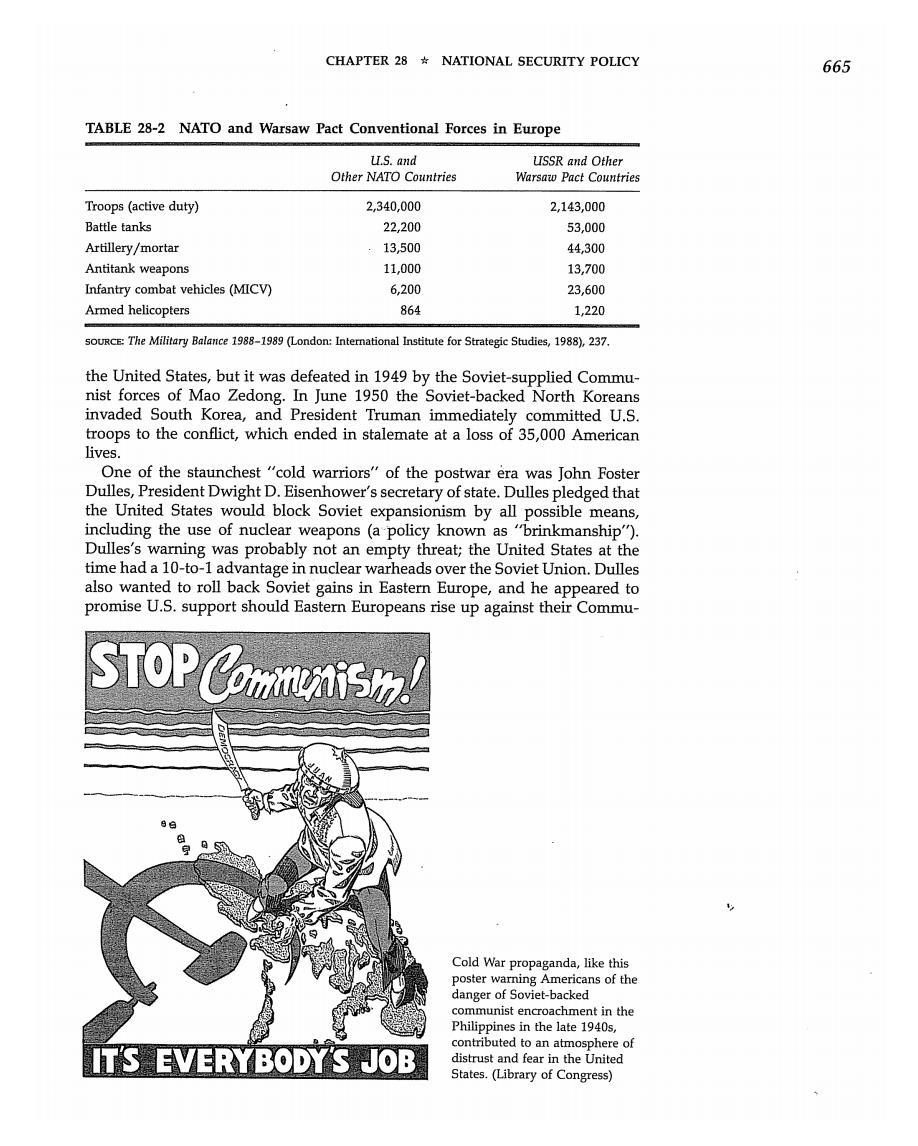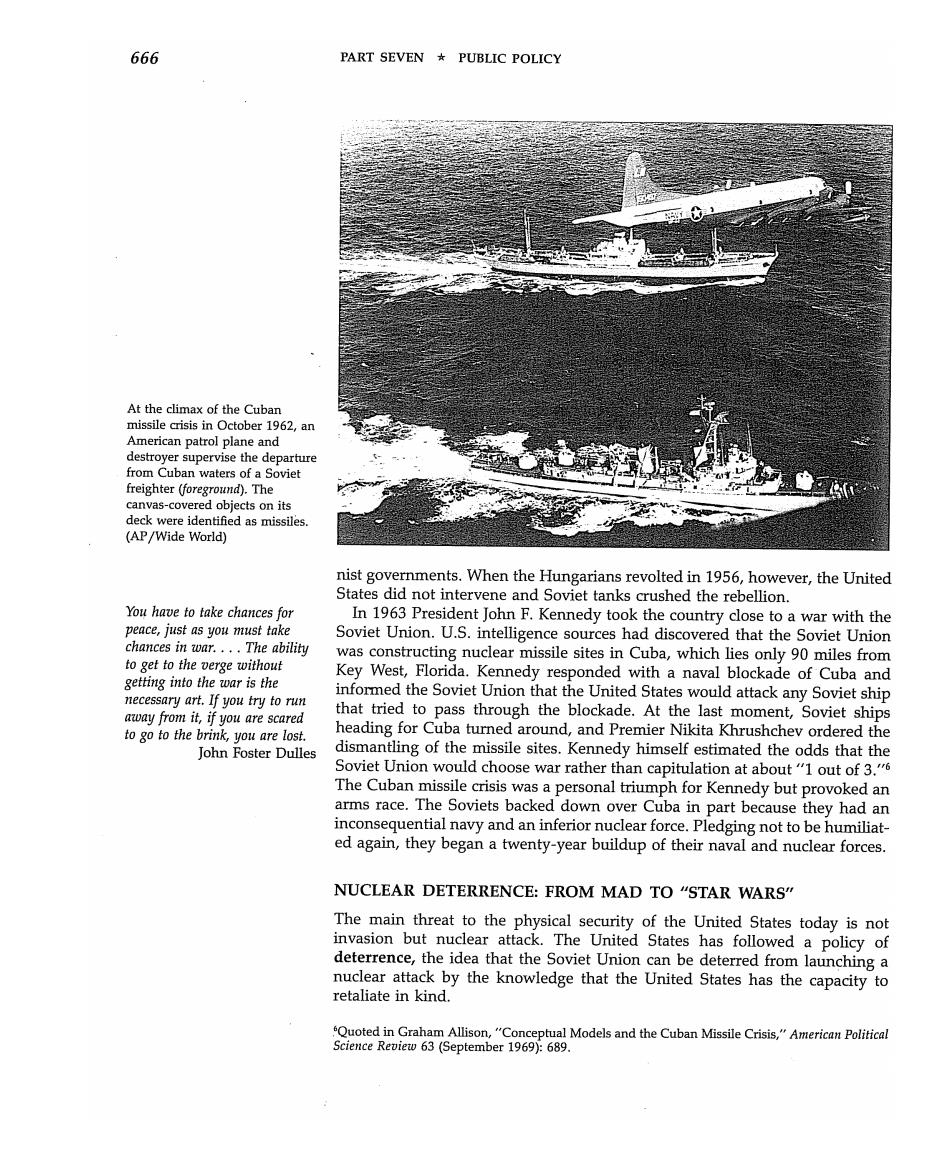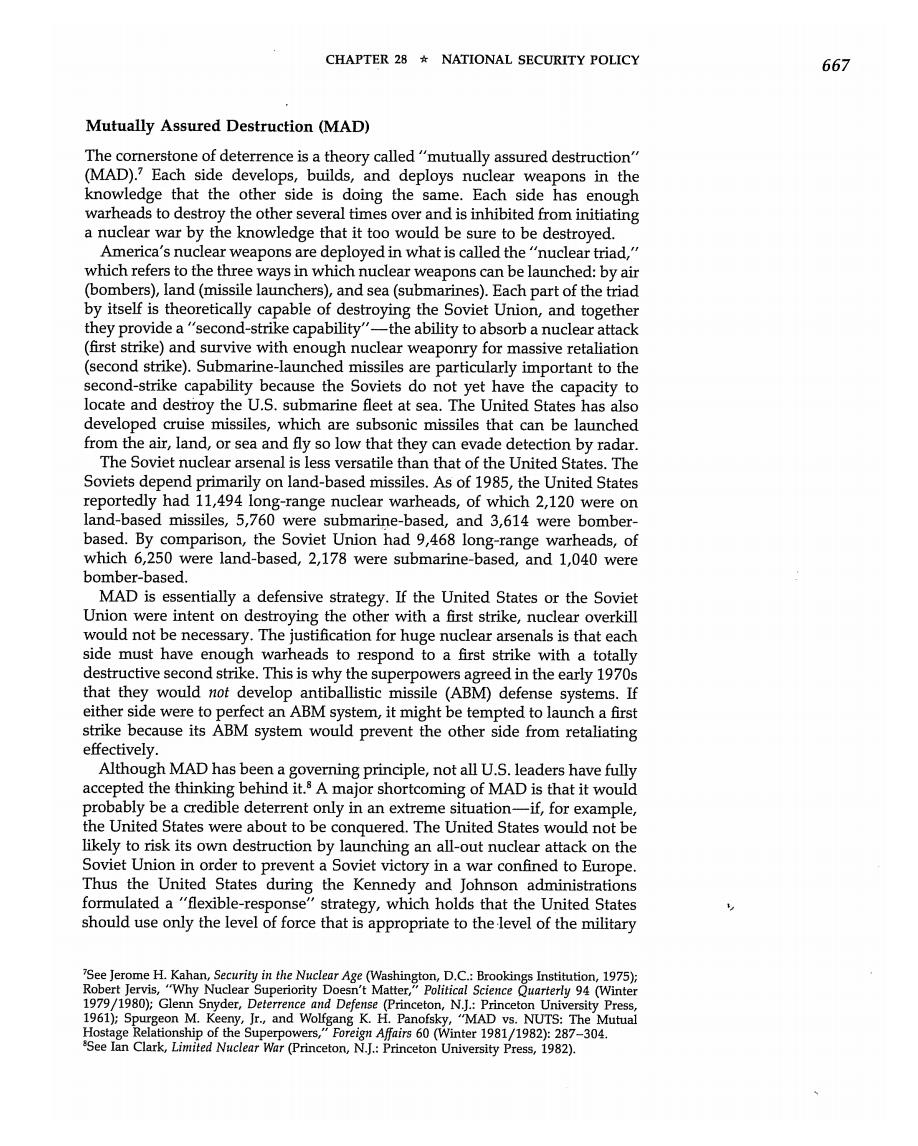
664 PART SEVEN PUBLIC POLICY ANALYZ正正1SSUE Containment policy also dictated that the United States maintain a military Short-Term Analysis of presence on the Soviet Union's flanks.After World War II,instead of demobiliz- Policy Costs ing its military forces as it had done at the end of World War I,the United States When the Marshall Plan was ordered its troops to occupy Japan and a section of West Germany. proposed,opponents labeled Today the United States has more than 2 million military personnel,about it a giveaway.Why,they asked,should America give 500,000 of whom are stationed overseas(see Table 28-1).There are 65,000 U.S billions to help devastated troops in Japan and 40,000 in South Korea.Since World War II,Asia has twice European nations get back on been a battleground for U.S.forces,in the Korean and Vietnam wars. their feet?Why was this view Europe has the largest contingent of U.S.military personnel,with approxi- shortsighted?Can you think mately 250,000 in West Germany alone.These troops are linked with the of problems today,foreign or military forces of America's allies in the North Atlantic Treaty Organization domestic,in which an obsessive concern for (NATO).NATO countries conduct joint military exercises and engage in joint short-term costs has led strategic and tactical military planning that centers on the defense of Western policymakers to oppose Europe.The NATO forces are under an integrated command except for France, programs that would provide which since the mid-1960s has maintained full command of its own forces significant long-term benefits? NATO is countered by the Warsaw Pact,which consists of the Soviet Union and What are some plausible reasons for officials to fail to its Eastern European allies.The Warsaw Pact has a numerical edge in equipment take the long view? (see Table 28-2),while NATO has more technically advanced weaponry. THE COLD WAR ANAY7Z正正1s5UE霸 Developments in the late 1940s embroiled the United States in a cold war with The Effectiveness of the the Soviet Union.The term refers to the fact that the two countries were not Containment Doctrine The dominant view among directly engaged in actual combat(a"hot war"),but were locked in deep-seated Western leaders after World hostility.From the United States'perspective,the cold war was an extension of War II was that aggression containment policy and included support for governments threatened by should never be rewarded communist takeovers.In China the Nationalist government had the support of because it only encourages the aggressor nation to seek TABLE 28-1 Number of U.S.Military further gains.As a result of Personnel around the World,1988 this view,Western nations concluded that containment Military was the best strategy to adopt Area Personnel toward the Soviet Union.Do you think this view was the U.S.territory 1,677,040 correct one?Can you think of Western Europe postwar developments that West Germany 245,700 support your position?Do United Kingdom 29,800 you think this view is still Italy 9,750 applicable today?Are there Other 42,960 recent examples to support All Western Europe 328,210 your position? East Asia and Pacific Japan 64,700 South Korea 40,200 Philippines 16,400 Other 11,650 All East Asia and Pacific 132,950 Other overseas (estimated) 25,000 All areas 2,163,200 SoURCE:Calculated from The Military Balance 1988 1989 (London:International Institute for Strategic Studies,1988),18,25-28

CHAPTER 28*NATIONAL SECURITY POLICY 665 TABLE 28-2 NATO and Warsaw Pact Conventional Forces in Europe U.S.and USSR and Other Other NATO Countries Warsaw Pact Countries Troops(active duty) 2,340,000 2,143,000 Battle tanks 22,200 53,000 Artillery/mortar 13,500 44,300 Antitank weapons 11,000 13,700 Infantry combat vehicles(MICV) 6,200 23,600 Armed helicopters 864 1,220 soURCE:The Military Balance 1988-1989(London:International Institute for Strategic Studies,1988),237 the United States,but it was defeated in 1949 by the Soviet-supplied Commu- nist forces of Mao Zedong.In June 1950 the Soviet-backed North Koreans invaded South Korea,and President Truman immediately committed U.S. troops to the conflict,which ended in stalemate at a loss of 35,000 American lives. One of the staunchest "cold warriors"of the postwar era was John Foster Dulles,President Dwight D.Eisenhower's secretary of state.Dulles pledged that the United States would block Soviet expansionism by all possible means including the use of nuclear weapons (a policy known as "brinkmanship"). Dulles's warning was probably not an empty threat;the United States at the time had a 10-to-1 advantage in nuclear warheads over the Soviet Union.Dulles also wanted to roll back Soviet gains in Eastern Europe,and he appeared to promise U.S.support should Eastern Europeans rise up against their Commu- STOPCmmis Cold War propaganda,like this poster warning Americans of the danger of Soviet-backed communist encroachment in the Philippines in the late 1940s. contributed to an atmosphere of IT'S EVERYBODY'S JOB distrust and fear in the United States.(Library of Congress)

666 PART SEVEN PUBLIC POLICY At the climax of the Cuban missile crisis in October 1962,an American patrol plane and destroyer supervise the departure from Cuban waters of a Soviet freighter (foreground).The canvas-covered objects on its deck were identified as missiles (AP/Wide World) nist governments.When the Hungarians revolted in 1956,however,the United States did not intervene and Soviet tanks crushed the rebellion. You have to take chances for In 1963 President John F.Kennedy took the country close to a war with the peace,just as you must take Soviet Union.U.S.intelligence sources had discovered that the Soviet Union chances in war....The ability was constructing nuclear missile sites in Cuba,which lies only 90 miles from to get to the verge without getting into the war is the Key West,Florida.Kennedy responded with a naval blockade of Cuba and necessary art.If you try to run informed the Soviet Union that the United States would attack any Soviet ship away from it,if you are scared that tried to pass through the blockade.At the last moment,Soviet ships to go to the brink,you are lost. heading for Cuba turned around,and Premier Nikita Khrushchev ordered the John Foster Dulles dismantling of the missile sites.Kennedy himself estimated the odds that the Soviet Union would choose war rather than capitulation at about"1 out of 3."6 The Cuban missile crisis was a personal triumph for Kennedy but provoked an arms race.The Soviets backed down over Cuba in part because they had an inconsequential navy and an inferior nuclear force.Pledging not to be humiliat- ed again,they began a twenty-year buildup of their naval and nuclear forces. NUCLEAR DETERRENCE:FROM MAD TO "STAR WARS" The main threat to the physical security of the United States today is not invasion but nuclear attack.The United States has followed a policy of deterrence,the idea that the Soviet Union can be deterred from launching a nuclear attack by the knowledge that the United States has the capacity to retaliate in kind. Quoted in Graham Allison,"Conceptual Models and the Cuban Missile Crisis,"American Political Science Review 63(September 1969):689

CHAPTER 28*NATIONAL SECURITY POLICY 667 Mutually Assured Destruction (MAD) The cornerstone of deterrence is a theory called"mutually assured destruction" (MAD).?Each side develops,builds,and deploys nuclear weapons in the knowledge that the other side is doing the same.Each side has enough warheads to destroy the other several times over and is inhibited from initiating a nuclear war by the knowledge that it too would be sure to be destroyed. America's nuclear weapons are deployed in what is called the"nuclear triad," which refers to the three ways in which nuclear weapons can be launched:by air (bombers),land(missile launchers),and sea(submarines).Each part of the triad by itself is theoretically capable of destroying the Soviet Union,and together they provide a"second-strike capability"-the ability to absorb a nuclear attack (first strike)and survive with enough nuclear weaponry for massive retaliation (second strike).Submarine-launched missiles are particularly important to the second-strike capability because the Soviets do not yet have the capacity to locate and destroy the U.S.submarine fleet at sea.The United States has also developed cruise missiles,which are subsonic missiles that can be launched from the air,land,or sea and fly so low that they can evade detection by radar. The Soviet nuclear arsenal is less versatile than that of the United States.The Soviets depend primarily on land-based missiles.As of 1985,the United States reportedly had 11,494 long-range nuclear warheads,of which 2,120 were on land-based missiles,5,760 were submarine-based,and 3,614 were bomber- based.By comparison,the Soviet Union had 9,468 long-range warheads,of which 6,250 were land-based,2,178 were submarine-based,and 1,040 were bomber-based. MAD is essentially a defensive strategy.If the United States or the Soviet Union were intent on destroying the other with a first strike,nuclear overkill would not be necessary.The justification for huge nuclear arsenals is that each side must have enough warheads to respond to a first strike with a totally destructive second strike.This is why the superpowers agreed in the early 1970s that they would not develop antiballistic missile(ABM)defense systems.If either side were to perfect an ABM system,it might be tempted to launch a first strike because its ABM system would prevent the other side from retaliating effectively. Although MAD has been a governing principle,not all U.S.leaders have fully accepted the thinking behind it.s A major shortcoming of MAD is that it would probably be a credible deterrent only in an extreme situation-if,for example the United States were about to be conquered.The United States would not be likely to risk its own destruction by launching an all-out nuclear attack on the Soviet Union in order to prevent a Soviet victory in a war confined to Europe. Thus the United States during the Kennedy and Johnson administrations formulated a"flexible-response"strategy,which holds that the United States should use only the level of force that is appropriate to the level of the military 7See Jerome H.Kahan,Security in the Nuclear Age(Washington,D.C.:Brookings Institution,1975); Robert Jervis,"Why Nuclear Superiority Doesn't Matter,"Political Science Quarterly 94(Winter 1979/1980);Glenn Snyder,Deterrence and Defense (Princeton,N.J.:Princeton University Press, 1961);Spurgeon M.Keeny,Jr.,and Wolfgang K.H.Panofsky,"MAD vs.NUTS:The Mutual Hostage Relationship of the Superpowers,"Foreign Affairs 60(Winter 1981/1982):287-304. See Ian Clark,Limited Nuclear War(Princeton,N.J.:Princeton University Press,1982)